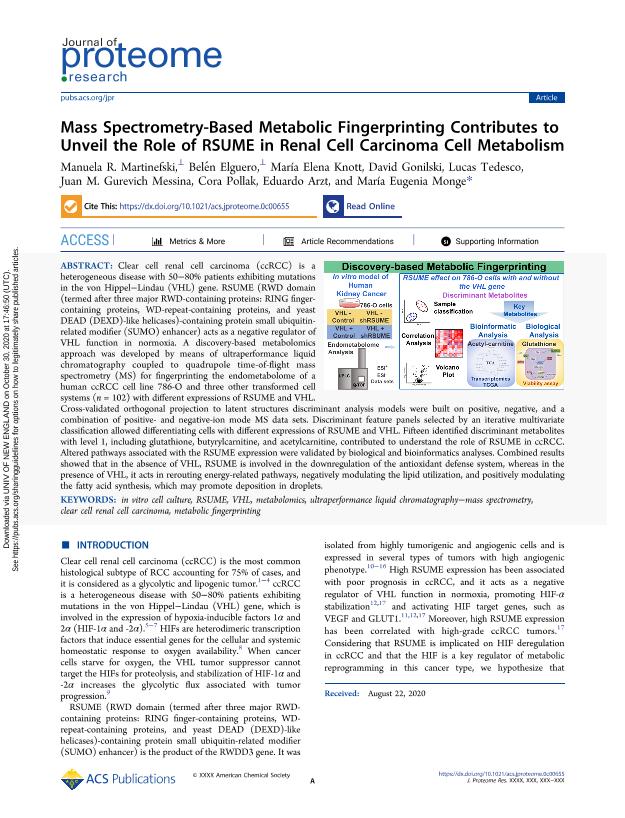Artículo
Mass Spectrometry-Based Metabolic Fingerprinting Contributes to Unveil the Role of RSUME in Renal Cell Carcinoma Cell Metabolism
Martinefski, Manuela Romina ; Elguero, María Belén
; Elguero, María Belén ; Knott, María Elena
; Knott, María Elena ; Gonilski Pacin, David Nicolás
; Gonilski Pacin, David Nicolás ; Tedesco, Lucas
; Tedesco, Lucas ; Gurevich Messina, Juan Manuel
; Gurevich Messina, Juan Manuel ; Pollak, Cora Noemí
; Pollak, Cora Noemí ; Arzt, Eduardo Simon
; Arzt, Eduardo Simon ; Monge, Maria Eugenia
; Monge, Maria Eugenia
 ; Elguero, María Belén
; Elguero, María Belén ; Knott, María Elena
; Knott, María Elena ; Gonilski Pacin, David Nicolás
; Gonilski Pacin, David Nicolás ; Tedesco, Lucas
; Tedesco, Lucas ; Gurevich Messina, Juan Manuel
; Gurevich Messina, Juan Manuel ; Pollak, Cora Noemí
; Pollak, Cora Noemí ; Arzt, Eduardo Simon
; Arzt, Eduardo Simon ; Monge, Maria Eugenia
; Monge, Maria Eugenia
Fecha de publicación:
10/2020
Editorial:
American Chemical Society
Revista:
Journal of Proteome Research
ISSN:
1535-3893
Idioma:
Inglés
Tipo de recurso:
Artículo publicado
Clasificación temática:
Resumen
Clear cell renal cell carcinoma (ccRCC) is a heterogeneous disease with 50-80% patients exhibiting mutations in the von Hippel-Lindau (VHL) gene. RSUME (RWD domain (termed after three major RWD-containing proteins: RING finger-containing proteins, WD-repeat-containing proteins, and yeast DEAD (DEXD)-like helicases)-containing protein small ubiquitin-related modifier (SUMO) enhancer) acts as a negative regulator of VHL function in normoxia. A discovery-based metabolomics approach was developed by means of ultraperformance liquid chromatography coupled to quadrupole time-of-flight mass spectrometry (MS) for fingerprinting the endometabolome of a human ccRCC cell line 786-O and three other transformed cell systems (n = 102) with different expressions of RSUME and VHL. Cross-validated orthogonal projection to latent structures discriminant analysis models were built on positive, negative, and a combination of positive- and negative-ion mode MS data sets. Discriminant feature panels selected by an iterative multivariate classification allowed differentiating cells with different expressions of RSUME and VHL. Fifteen identified discriminant metabolites with level 1, including glutathione, butyrylcarnitine, and acetylcarnitine, contributed to understand the role of RSUME in ccRCC. Altered pathways associated with the RSUME expression were validated by biological and bioinformatics analyses. Combined results showed that in the absence of VHL, RSUME is involved in the downregulation of the antioxidant defense system, whereas in the presence of VHL, it acts in rerouting energy-related pathways, negatively modulating the lipid utilization, and positively modulating the fatty acid synthesis, which may promote deposition in droplets.
Archivos asociados
Licencia
Identificadores
Colecciones
Articulos(CIBION)
Articulos de CENTRO DE INVESTIGACIONES EN BIONANOCIENCIAS "ELIZABETH JARES ERIJMAN"
Articulos de CENTRO DE INVESTIGACIONES EN BIONANOCIENCIAS "ELIZABETH JARES ERIJMAN"
Articulos(IBIOBA - MPSP)
Articulos de INST. D/INV.EN BIOMED.DE BS AS-CONICET-INST. PARTNER SOCIEDAD MAX PLANCK
Articulos de INST. D/INV.EN BIOMED.DE BS AS-CONICET-INST. PARTNER SOCIEDAD MAX PLANCK
Citación
Martinefski, Manuela Romina; Elguero, María Belén; Knott, María Elena; Gonilski Pacin, David Nicolás; Tedesco, Lucas; et al.; Mass Spectrometry-Based Metabolic Fingerprinting Contributes to Unveil the Role of RSUME in Renal Cell Carcinoma Cell Metabolism; American Chemical Society; Journal of Proteome Research; 20; 1; 10-2020; 786-803
Compartir
Altmétricas



